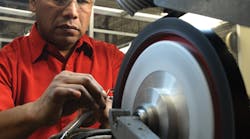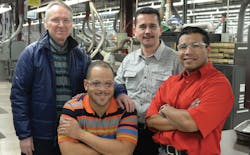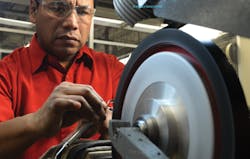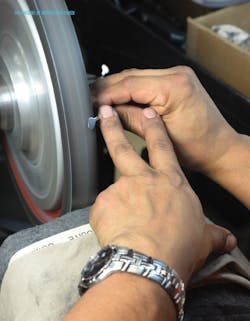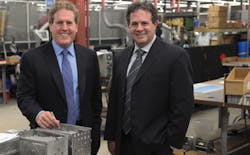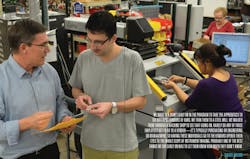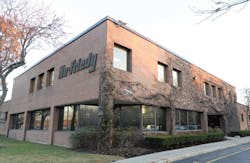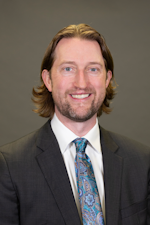The making of master craftsmen: Inside the groundbreaking Hu-Friedy apprenticeship program
To enter the Hu-Friedy manufacturing facility in Chicago, you must pass through a room known as the Hall of Fame. On the walls of this room are wooden plaques, each bearing a bronze-colored plate with the name and face of a Hu-Friedy employee. The plaques are organized by years of service, with the first milestone being five years. If you take a close look, you will find a good number of employees at the 5, 10, and 15-year marks. But consider the scene a little longer and you will notice something else: In the Hall of Fame, there are a striking number of employees with 20 years of service, 30 years of service, 40 years of service . . . and beyond. Before you’ve even left the room, then, two things are clear: First, there is no shortage of experience on the production floor at Hu-Friedy; and second, this is a place where you could, quite literally, start and finish your entire working life.
And for Claude Brown, therein lies the dilemma.
As senior vice president of global operations, Claude Brown is responsible for maintaining the manufacturing backbone of this 108-year old, family-owned company. On the one hand, Brown can take comfort in a stable and reliable workforce—one that will continue to age gracefully in the Hu-Friedy Hall of Fame. But on the other hand, Brown knows stability can be a dangerous thing. That’s because key areas of Hu-Friedy’s business rely on craftsmanship, i.e., the artistic part of the manufacturing process. It’s the side of manufacturing that most of us don’t think about in a world of robotic automation. You see, to make the world’s best dental instruments in the 21st century (the goal Hu-Friedy doggedly pursues), the company relies on both cutting-edge technology and the delicacy of the human hand. That means all those 20- and 30-year plaques in the Hall of Fame can’t be replaced by cheaper labor overseas, an expensive machine, or simply hiring off the street. To put it another way, it’s as if all those plaques are whispering: “When we finally retire, it will take decades to replace us.”
So if you’re Brown, what do you do? How do you revitalize an aging employee-base without jeopardizing Hu-Friedy’s legendary commitment to quality? How do you create master craftsmen who can be leaders on the manufacturing floor? How do you give employees tools and opportunities to catalyze innovation? And how do you do all that without breaking the budget?
The answer, it turns out, was simple: You reinvent yourself from within.
Above: Lead apprentice teacher and instrument maker Martin Schnekenburger, pictured here with apprentices Antjuan Patterson, Javier Araque, and Victor Espadas. Along with apprentice Tam Nguyen (not pictured), Patterson, Araque, and Espadas make up the first class of Hu-Friedy’s apprenticeship program.
* * *
Welcome to the Hu-Friedy apprenticeship program, a program that is making other companies rethink what it means to be a US manufacturer in the global marketplace. Established in 2014, the two-year apprenticeship program aims to make Hu-Friedy’s best employees even better.
Starting with a thorough application process, a small group of employees are selected for the program. They are taken completely away from their full-time jobs and go back to the classroom, where they learn key manufacturing processes such as metallurgy and heat-treatment. They shadow other employees and learn how to perform all the key tasks in the production line: grinding, polishing, diagnostics, quality control . . . and on and on. They are sent to Hu-Friedy’s vendors, such as those who supply the company with steel and raw materials, to learn where the process begins. They work with instructors, some of whom are the premier experts in their fields, and take 100-question tests and quizzes. They learn what the dental instruments are used for and why precision is so important when manufacturing a surgical instrument. And at the end of it all, they graduate as the company’s newest cohort of master instrument makers.
To select the apprentices, Brown opted for a self-nomination system in which only current employees were allowed to apply. So why not hand pick the apprentices himself or assign a committee to do it? “I really only wanted individuals who wanted to be in the program,” Brown says. “It was going to be different; it was going to require a lot of commitment on their part.”
Brown continues, “They were going to have to change their hours based on some things. It wasn’t going to be a standard eight-to-five job. Sometimes they would have to come in at six in the morning, sometimes they would have to go out on vendor visits. So I only wanted those individuals who were ready to commit themselves to it.”
The apprentices see the commitment as a rigorous learning process, too, referring to it at times as “Hu-Friedy University.” And like a university, there was a financial commitment involved—only the cost was borne entirely by the company. The apprentices aren’t doing their normal jobs, so Hu-Friedy had to backfill their positions. To try to make the program successful in its first year, the company had to develop resources up front. This included investing in classroom materials, training processes, coordination of the program, and ways to be sure the information was truly sinking in.
But if the program was going to be truly successful, it would need to be sustainable. Through the years, it would need to generate enough master craftsmen to support Hu-Friedy’s projected growth. That meant the company had to commit to a new class of apprentices in 2016, 2018, 2020, etc. To build that kind of program, one in which the payoff may not be seen for years down the road, it needed company-wide support. To get the program off the ground, Brown went to those holding the reigns to Hu-Friedy’s long-term business strategy, CEO and Chairman Ron Saslow and President Ken Serota.
Above: Hu-Friedy CEO Ron Saslow and President Ken Serota
* * *
“This wasn’t going to be a one and done.”
When the top executives at Hu-Friedy weighed the merits of a potential apprenticeship program, there was a part that was easy and a part that was hard. The easy part was seeing how the program fell in line with the company’s philosophy. “It made sense to us,” says President Ken Serota. “The way we manufacture our instruments is unique. They’re very much handmade—it’s not just cranked out manufacturing. Quite honestly, we’ve talked about this over the years in various areas of Hu-Friedy beyond the plant: How we make sure to continue to build a legacy that is over 100 years old.”
The hard part, ironically, was what Hu-Friedy does best: Getting the details right.
“This is a very significant financial commitment on behalf of the company,” Serota says. “We’ve taken the people out of their full-time jobs, and obviously we didn’t just pick anybody to be our pilots for this program. These are very high-potential, high-performance people who we selected. So first and foremost I wanted to be sure we had a solid plan to replace that knowledge and productivity on the factory floor when we committed to this program.”
Other details included the length of the program (two years was considered to be sufficiently comprehensive), who would do training (the company has brought in experts from across the industry), and how candidates would be vetted (“This wasn’t going to be a ‘one and done,’” says Serota). The result was a program deemed to be financially sound, sufficiently rigorous, and highly sustainable.
Serota points out, however, that the program didn’t arise simply because there was a need for it. Serota believes it wouldn’t have been established were it not for the prevailing attitude of collaboration in the company. “It’s not just [CEO Ron Saslow] or me driving the divisions or coming up with ideas,” he says. “Hu-Friedy is a very collaborative company—it’s one of the things that drew me here. Input is encouraged from everybody. It’s not just Ron or me sitting in our ivory tower making policy. Really our great ideas come from all over.”
In addition to collaboration, the company culture embraces the belief that manufacturing can work in the US. For CEO Ron Saslow, the “made-in-America concept” can still work, despite the word on the street. “You hear so many people in so many places—the media, the government, everywhere—claiming that manufacturing is leaving the US,” he says. “You hear we’ve lost our skill set, and we’ve lost our ability to compete on a global basis. We don’t subscribe to that point of view. But a piece of the apprentice program, and it is an important piece as well, was a little bit of giving back to the community and the people around us. We decided we are in a great position leadership-wise, and even in our area, the Chicago-land area, to turn that [manufacturing] trend around.”
As fewer workers come out of tech schools with manufacturing skills, Saslow says that the commitment to an internal solution was critical. Still, Saslow is realistic. “It won’t be easy and it won’t be fast, but we plan to stay in Chicago for many years to come and we are committed to making this work.”
Early showings, however, are positive. When the apprentice program was featured last summer in the Wall Street Journal, Saslow received a number of calls from companies who wanted to learn more. “It forced them to look at their organization and ask if they had a similar opportunity to do what we were doing,” he says. “As I heard them talk about it, it was neat to hear the congratulations on the piece and that it really caused them to reflect on their own business practices and training and developing the people in their own organizations..”
“Hu-Friedy University”
Antjuan Patterson and Javier Araque are two of the four apprentices attending “Hu-Friedy University,” the informal name they’ve given to the apprentice program. They come to the program from different backgrounds. While Patterson has been with the company for eight years, Araque has been with the company for 27. They both, however, have key similarities: They are equally serious about the opportunity. They have equally strong desires to be master instrument makers. They both want to do their part to help the program succeed. They both want others to follow in their footsteps. Finally, they both want to be role models for their peers.
So why did they apply, and why were they chosen? “I would consider myself a go-to guy,” says Patterson. “Anything the company needs, I try to do it. When I started here I was actually on the third shift. My position here was from eleven at night to seven in the morning. I started that way just to—I don’t want to say ‘prove myself’—but basically that was it. I wanted to start from the bottom and come up to the top. The company really took heed to that. I guess they appreciated the work I and the other apprentices had done over the years, and that’s why they considered us the best people for this.”
For Araque, the program is an extension of everything he likes about working there. “Hu-Friedy is the kind of company that cares about its employees,” he says. “When we started, we would go to other companies. And when we did, we would fall more in love with Hu-Friedy. We know the program’s been great because it’s giving us knowledge to understand everything. This is going to be an excellent program for others in the future. This is a great idea.”
“The next generation of instrument makers.”
As you walk out of the Hu-Friedy manufacturing facility, you pass back through the Hall of Fame. But knowing about the apprenticeship program, you have a different perspective on what all those plaques are saying about the company. Instead of an organization that is aging out, the youngest faces in the Hall of Fame are those who will meet the future challenges facing the company.
For Brown, the future is bright. “We’re training the next generation of instrument makers,” he says. “We want new perspectives to help us drive development and innovation. When the instrument makers go into a new area of the program, they’re coming up with some great ideas. With a fresh set of eyes and a little background, they generate unique ideas on how to improve the process or improve the quality. It’s early on, but I’ve already seen signs of this. They’re asking a ton of questions, and they’re not just accepting the status quo. They continue to challenge the process, push to make us better and strengthen who we are today. My hope is that once they graduate and get back on the floor full time, that’s exactly what they’ll do.”
Zachary Kulsrud is the senior editor of Apex360 and PennWell's dental group, which includes managing editor duties for Dental Economics and DentistryIQ.com. Email him at [email protected].
Photos by Fred Smith Associates/Bob Mead. Photo of Hall of Fame courtesy of Hu-Friedy.
Magazine layout design and creative direction by Chad Wimmer.
This article first appeared in the Apex360digital magazine. Access the issue by subscribing here.
Also by Zachary Kulsrud:Dental office design, reborn in Portland
